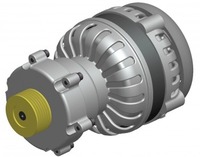Dual-speed ancillaries can deliver 5% reduction in fuel consumption
 Simple dual-speed drives can help alternators and other engine ancillaries operate more efficiently, by better matching their drive speed to the vehicle requirements, and improve the re-charging of batteries says vehicle transmission specialist Antonov Automotive Technologies. The UK-based company has informed carmakers and industry experts attending the inaugural Cenex event held last week at Millbrook Proving Ground and is also presenting its findings this week at an SAE powertrain conference in Texas.
Simple dual-speed drives can help alternators and other engine ancillaries operate more efficiently, by better matching their drive speed to the vehicle requirements, and improve the re-charging of batteries says vehicle transmission specialist Antonov Automotive Technologies. The UK-based company has informed carmakers and industry experts attending the inaugural Cenex event held last week at Millbrook Proving Ground and is also presenting its findings this week at an SAE powertrain conference in Texas. The characteristics of Antonov‘s innovative mechanical module (AMM), essentially a self controlling automatic two-speed gearset, can be tuned to meet specific vehicle requirements. For example, mated to an alternator it provides improved alternator matching to give good charge at engine idle without incurring losses at higher engine speeds. In this application, it can also provide a reduction drive to enable a compact front mounted starter-alternator to be used for engine stop-start operation. The company, which is developing the system for OEM applications, says a dual-speed alternator designed for stop-start operation can deliver an 18 per cent saving of electrical energy over a typical light commercial vehicle duty cycle.
It can also be applied as a dual-pulley unit to give a two-speed belt driven alternator, air-conditioning pump and water pump, whereby the accumulated energy saving translates into a 5.6 per cent reduction in fuel consumption. This is achieved with a 2-to-1 gear ratio change at 2,000rpm. Ultimately, the company aims to introduce a compact unit that is mounted directly to the engine crankshaft, but this will require much greater development integration with the base engine.
“Customers and legislators are placing more demands on vehicle electrical power, with lower emissions meaning smaller petrol and diesel engines, lower engine idle speeds and more stop-start systems,” says Chris Baylis operations director Antonov. “Even daytime headlight legislation is increasing the electrical load.”
The introduction by carmakers of belt-driven stop-start systems and other technical developments, such as downsized engines, is increasing the need for more efficient electrical systems. Vehicle manufacturers also want more engine torque at low engine speeds to improve driveability as well as better fuel efficiency.
“Maximising the overall operating efficiency with fixed drive alternators, water-pumps, superchargers - indeed any crankshaft driven or electric motor ancillary - is becoming more and more difficult,” says Baylis. “At high engine speeds this can result in unacceptable losses or even excessive speeding outside their most efficient operating range.”
Applied to an alternator, the Antonov dual-speed module can increase the electrical output for regenerative braking and reduce engine idle speed without battery charging issues. A smaller dual-speed alternator can match the low engine speed output of a larger more expensive alternator, and there is also reduced noise at higher engine speeds.
Another application of Antonov’s AMM device is to facilitate low cost engine downsizing. As demonstrated at the Cenex low carbon vehicle event, it can be used as a 2-speed drive with a centrifugal supercharger. The resultant higher drive ratio at low engine speeds provides a big engine feel from a small engine, allowing for less gear down changing and improved fuel economy.
Antonov is similarly pursuing the development of its mechanical module as a 2-speed electric vehicle transmission, whereby it’s either packaged into the electric motor as part of the reduction gearing, installed as a separate dual-speed unit or as part of the transaxle. The AMM device requires no external control, with its characteristics predetermined at the design stage. The high transmission efficiency of a purely mechanical system ensures minimum losses through the driveline.
Two Antonov epicyclical sets can also be incorporated as a binary system to create a simple fully mechanical fully automatic 4-speed transmission, which is ideal for the low-cost cars required in third world and emerging markets. The very low costs are achieving by not having any hydraulic systems or transmission control units. Maximum efficiency is delivered by only slipping two clutches in 1st gear, one clutch in 2nd and 3rd gears, no clutches slipping in 4th gear and no high pressure oil pump.
Baylis will describe the technology inside Antonov’s innovative mechanical shift system and how it all works in a comprehensive presentation to automotive engineers and industry experts attending an SAE symposium this week at the headquarters of the SwRI (Southwest Research Institute) at San Antonio in Texas. The three-day event runs from 4-6 November 2008 (sae.org/opt). The conference is focused on new strategies for the optimisation of vehicle powertrain systems.
To further underline its vehicle environmental credentials, Antonov also participated last week in the inaugural National Low Carbon Vehicle event held at Millbrook Proving Ground, where the company exhibited its AMM technology and took part in ride and drive activities with a typical family saloon equipped with a dual-speed supercharger. The largest gathering to date of the UK’s low carbon automotive supply chain was hosted by Cenex (cenex.co.uk), the UK’s first national centre of excellence for low carbon vehicle technologies.
Further information on Antonov technology is available at antonovat.com

